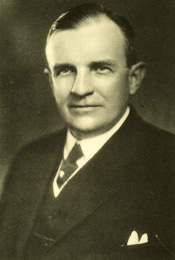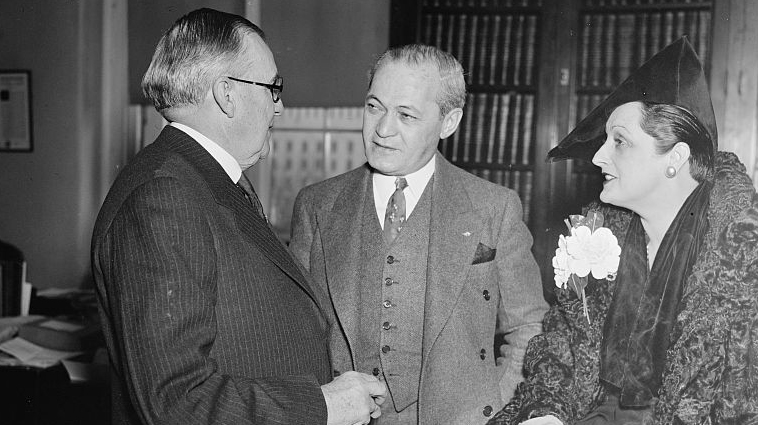Kerr, John Hosea
30 Dec. 1873–21 June 1958
 John Hosea Kerr, lawyer, Superior Court solicitor and judge, and congressman, was born at Yanceyville, the son of John Hosea McNeill and Eliza Catherine Yancey Kerr, great niece of Bartlett Yancey and granddaughter of James Yancey. His father was an officer in the Confederate Army and served for a number of years as clerk of court in Caswell County. Young Kerr was educated in the Yanceyville schools and Bingham School at Mebane; he received the bachelor of arts degree from Wake Forest College in 1895. One of the early students of law at Wake Forest, he was awarded the honorary doctor of law degree from the college on 4 June 1945.
John Hosea Kerr, lawyer, Superior Court solicitor and judge, and congressman, was born at Yanceyville, the son of John Hosea McNeill and Eliza Catherine Yancey Kerr, great niece of Bartlett Yancey and granddaughter of James Yancey. His father was an officer in the Confederate Army and served for a number of years as clerk of court in Caswell County. Young Kerr was educated in the Yanceyville schools and Bingham School at Mebane; he received the bachelor of arts degree from Wake Forest College in 1895. One of the early students of law at Wake Forest, he was awarded the honorary doctor of law degree from the college on 4 June 1945.
In the fall of 1895, Kerr received his license and began to practice law in Warrenton. He served as town attorney and for two terms as mayor (1897–98). In these positions he was instrumental in having the Warrenton charter amended to permit the municipality to own and operate businesses, including a dispensary for the sale of spirits, wine, and beer; a telephone company; a hotel; and a railroad. This policy brought Warrenton to the attention of local governments nationwide. In 1905 Kerr was elected solicitor of the Third Judicial District, a post he held for ten years. In November 1916 he was elected judge of the Superior Court and served until 1923. On the death of Claude Kitchin in 1923, Kerr was elected as a Democrat to Congress where he served fifteen consecutive terms until 1952. He was the third generation of his family bearing the name John Kerr to be elected to Congress.
While in Congress, he took a deep interest in the agricultural life of his district; he was particularly active in legislation affecting the cotton, peanut, and tobacco crops. Among his committee assignments, he was a member of the Public Buildings Committee, which was instrumental in the erection of many government buildings in the 1930s and 1940s—including the United States Supreme Court Building. On the Appropriations Committee, he served as vice-chairman of the subcommittee that handled military appropriations during World War II, and he was chairman of the Subcommittee on Subversive Organizations. Kerr was coauthor of the Kerr-Coolidge Immigration bill and the Kerr-Smith Tobacco Act of 1934. The latter legislation evolved into a governmental program of price supports and allotments for tobacco farmers, which proved to be of tremendous economic benefit to North Carolina and other tobacco-producing regions.
During the administration of President Franklin D. Roosevelt, Kerr was a close personal friend of Secretary of State Cordell Hull and was sent on diplomatic missions to Hawaii, Central America, and Europe. He served as chairman of the U.S. delegation to the Inter-America Travel Congress at Mexico City in 1941.
The Second Congressional District, which Kerr served for twenty-nine years, was traversed by the Roanoke River. The Roanoke had a history of severe flooding, and in 1940 the waters produced by a devastating flood crested at Weldon at fifty-eight feet, six inches. In this thirtieth major flood along the Roanoke River basin since the Civil War, the entire crop in the Roanoke Valley was destroyed. The frequency of damaging floods caused Kerr to begin action for the location of a flood control project on the Roanoke River. Against the resistance of many, he secured passage of a congressional appropriation authorizing the investigation of such a project and a survey. Kerr secured the assistance of several colleagues from Virginia and North Carolina, and a flood control and  hydroelectric source dam was erected at Buggs Island, Va., at a cost of $100 million. Members of Congress paid tribute to his efforts by naming the facility, which was dedicated on 3 Oct. 1952, the John H. Kerr Dam and Reservoir. This project led to construction of Gaston Dam near Roanoke Rapids by the Virginia Electric and Power Company. The recreational features alone of the two projects (Kerr Lake having 880 miles of shoreline) has produced an economic revolution in the Roanoke Valley, which runs through northeastern North Carolina and southside Virginia.
hydroelectric source dam was erected at Buggs Island, Va., at a cost of $100 million. Members of Congress paid tribute to his efforts by naming the facility, which was dedicated on 3 Oct. 1952, the John H. Kerr Dam and Reservoir. This project led to construction of Gaston Dam near Roanoke Rapids by the Virginia Electric and Power Company. The recreational features alone of the two projects (Kerr Lake having 880 miles of shoreline) has produced an economic revolution in the Roanoke Valley, which runs through northeastern North Carolina and southside Virginia.
On 15 Feb. 1899 Kerr married Ella Lillian Foote, the daughter of Henry Alexander and Minnie Young Foote of Warrenton; her father was an attorney and the owner and publisher of the Warrenton Gazette. They were the parents of two sons: John H., Jr., an attorney and a member of the North Carolina House of Representatives and Senate for twelve terms (speaker of the house, 1943); and James Yancey, an attorney and tobacconist. Kerr was a Mason, a member of the Warrenton Baptist Church, a trustee of The University of North Carolina, and a member of the Board of Visitors of the U.S. Military Academy at West Point. He died in Warrenton, where he was buried in Fairview Cemetery.
References:
Biog. Dir. Am. Cong. (1950).
John L. Cheney, Jr., ed., North Carolina Government, 1585–1974 (1975).
Congressional Record, 5 July 1952.
History of North Carolina, vol. 5 (1919).
Robert C. Lawrence, Here in Carolina (1939).
Elizabeth Wilson Montgomery, Sketches of Old Warrenton (1924).
William S. Powell, When the Past Refused to Die: A History of Caswell County, North Carolina, 1777–1977 (1977).
Parke Rouse, Jr., Below the James Lies Dixie (1968).
W. O. Saunders, "The Town That Had Faith in Itself," Colliers, 17 Mar. 1923.
Warrenton, The Warren Record, 27 June 1958.
Manly Wade Wellman, The County of Warren, North Carolina (1959).
Who Was Who in America, 1951–1960, vol. 3 (1963).
Additional Resources:
"John H. Kerr 1873-1958." N.C. Highway Historical Marker E-102, N.C. Office of Archives & History. https://www.ncdcr.gov/about/history/division-historical-resources/nc-highway-historical-marker-program/Markers.aspx?sp=Markers&k=Markers&sv=E-102 (accessed April 10, 2013).
"Kerr, John Hosea, (1873 - 1958)." Biographical Directory of the United States Congress. Washington, D.C.: The Congress. http://bioguide.congress.gov/scripts/biodisplay.pl?index=k000138 (accessed April 10, 2013).
John Hosea Kerr Papers, 1923-1952 (collection no. 03358). The Southern Historical Collection. Louis Round Wilson Special Collections Library. University of North Carolina at Chapel Hill. http://www.lib.unc.edu/mss/inv/k/Kerr,John_Hosea.html (accessed April 10, 2013).
Caswell County Historical Association. "John Hosea Kerr (1844-1924)." Caswell County Historical Association. April 06, 2009. http://ncccha.blogspot.com/2009/04/john-hosea-kerr-1844-1924.html
Image Credits:
Office of the Clerk, U.S. House of Representatives. "KERR, John Hosea, (1873 - 1958)." Photograph. Biographical Directory of the United States Congress. Washington, D.C.: The Congress. http://bioguide.congress.gov/scripts/biodisplay.pl?index=k000138 (accessed April 10, 2013).
Harris & Ewing. "Rep. John H. Kerr of N.C., Rep. Samuel Dickstein, Chair, Fern Audro [sic] of Chicago, opera singer, immigration, house." Photograph. Harris & Ewing Collection. Prints and Photographs Division, Library of Congress. http://www.loc.gov/pictures/item/hec2009008994/
1 January 1988 | Kerr, John H., III